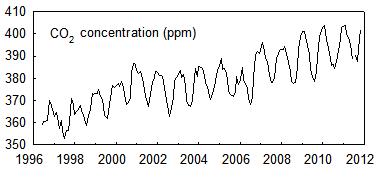In the Northern Hemisphere, the CO2 rises in the winter and declines in the summer, mainly as a response to the seasonal activity of forests, other land vegetation and algae which all absorb atmospheric CO2 both in oceans and in terrestrial biospheres and release it by heterotrophic respiration. In addition, house heating in winter contributes to the seasonal cycle of CO2 concentration.
CO2 concentration varies slightly during the day, where it’s the lowest during the daytime due to mixing of the atmospheric boundary layer and photosynthesis. During the calm moments at night, CO2 forms a vertical profile with highest concentration near the ground that acts as a intense CO2 source.
The particles in the animation reflect carbon dioxide (CO2) molecules that move according to the sink strength, photosynthesis and respiration, of the tree at each moment. The current atmospheric CO2 concentration is around 385 ppm (0.0385 %). The concentration increases annually by approximately 2 ppm.
